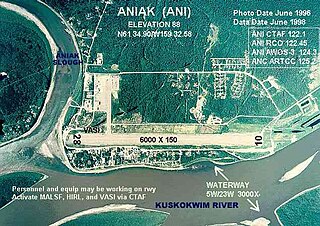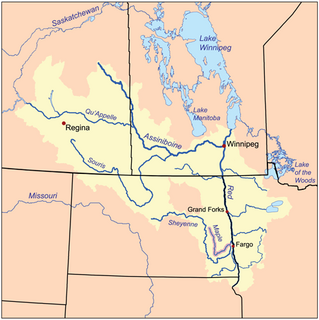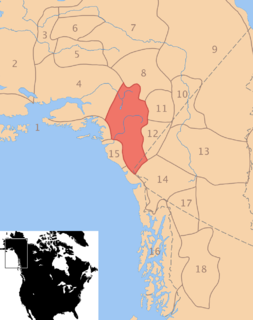Geography
Holikachuk Village is located in the Yukon-Koyukuk Census Area on the north bank of the Innoko River.
Holikachuk[ pronunciation? ] or Huligachagat (Xiyighelinghdi in Holikachuk language, Xiyeghelinghdi in Deg Xinag) is an abandoned village on the Innoko River in the U.S. state of Alaska.
A post office operated here from 1941 to 1964. [1] The residents of Holikachuk relocated to Grayling in 1962. [2] The name of the village is also the source for the name of the Holikachuk Athabaskan language.
Holikachuk Village is located in the Yukon-Koyukuk Census Area on the north bank of the Innoko River.
| Historical population | |||
|---|---|---|---|
| Census | Pop. | %± | |
| 1890 | 114 | — | |
| 1940 | 77 | — | |
| 1950 | 98 | 27.3% | |
| 1960 | 122 | 24.5% | |
| U.S. Decennial Census [3] | |||
Holikachuk first appeared on the 1890 U.S. Census as the unincorporated community of "Holikitsak." It next appeared on the 1940 U.S. Census as "Holocachaket." In 1950 and 1960, it returned as Holikachuk. Owing to its abandonment in the 1960s, it has not appeared on the census since.

The Yukon River is a major watercourse of northwestern North America. From its source in British Columbia, Canada, it flows through Canada's territory of Yukon. The lower half of the river continues westwards through the U.S. state of Alaska. The river is 3,190 kilometres (1,980 mi) long and empties into the Bering Sea at the Yukon–Kuskokwim Delta. The average flow is 6,400–7,000 m3/s (230,000–250,000 cu ft/s). The total drainage area is 833,000 km2 (321,500 sq mi), of which 323,800 km2 (125,000 sq mi) lies in Canada. The total area is more than 25% larger than Texas or Alberta.

Yukon–Koyukuk Census Area is a census area in the U.S. state of Alaska. As of the 2010 census, the population was 5,588. It has the largest area of any county or county-equivalent in the United States. It is part of the unorganized borough of Alaska and therefore has no borough seat. Its largest communities are the cities of Galena, in the west, and Fort Yukon, in the northeast.

Aniak is a city in the Bethel Census Area in the U.S. state of Alaska. At the 2010 census the population was 501, down from 572 in 2000.

Chuathbaluk is a city in Bethel Census Area, Alaska, United States.

Arctic Village is an unincorporated Native American village and a census-designated place (CDP) in Yukon-Koyukuk Census Area, Alaska, United States. As of the 2010 census, the population of the CDP was 152. This was unchanged from 2000. The village is located in the large Gwitch'in speaking region of Alaska, and the local dialect is known as Di'haii Gwitch'in or Kutchin. As of 1999, over 95% of the community speaks and understands the language.

Grayling is a city in Yukon-Koyukuk Census Area, Alaska, United States. At the 2010 census the population was 194, unchanged from 2000. Since 1977, the Athabaskan village has seen a surge of interest on odd-numbered years, when it is the site of a checkpoint during the Iditarod Trail Sled Dog Race. It is situated after the checkpoint at Anvik and before Eagle Island.

Shageluk is a city in Yukon-Koyukuk Census Area, Alaska, United States. At the 2010 census the population was 83, down from 129 in 2000.

Albers is a village in Clinton County, Illinois, United States. The population was 1,190 at the 2010 census.

Ransom is a village in LaSalle County, Illinois, United States. The population was 384 at the 2010 census. It is part of the Ottawa Micropolitan Statistical Area. It is part of the subregion known as Streatorland.

Athabaskan is a large family of indigenous languages of North America, located in western North America in three areal language groups: Northern, Pacific Coast and Southern. Kari and Potter (2010:10) place the total territory of the 53 Athabaskan languages at 4,022,000 square kilometres (1,553,000 sq mi).

The Innoko River (; is a 500-mile tributary of the Yukon River in the U.S. state of Alaska. It flows north from its origin south of Cloudy Mountain in the Kuskokwim Mountains and then southwest to meet the larger river across from Holy Cross.

Ophir is an unincorporated area located in the Yukon-Koyukuk Census Area in the U.S. state of Alaska.

The Iditarod River is a 325-mile (523 km) tributary of the Innoko River in the U.S. state of Alaska. The river begins north of Chuathbaluk and the Russian Mountains and flows northeast and then west to meet the larger river near Holikachuk.

Siouan or Siouan–Catawban is a language family of North America that is located primarily in the Great Plains, Ohio and Mississippi valleys and southeastern North America with a few other languages in the east.

The Maple River is a tributary of the Sheyenne River, about 198 miles (319 km) long, in the Red River Valley of eastern North Dakota in the United States. Via the Sheyenne River, the Red River of the North, Lake Winnipeg and the Nelson River, the Maple is part of the watershed of Hudson Bay.

Holikachuk are a Yupikized Alaska Native Athabaskan people of the Athabaskan-speaking ethnolinguistic group to western Alaska. Their native territory includes the area surrounding the middle and upper Innoko River. Later in 1963 they moved to Grayling on the Yukon River.
Holikachuk was an Athabaskan language formerly spoken at the village of Holikachuk (Hiyeghelinhdi) on the Innoko River in central Alaska. In 1962, residents of Holikachuk relocated to Grayling on the lower Yukon River. Holikachuk is intermediate between the Deg Xinag and Koyukon languages, linguistically closer to Koyukon but socially much closer to Deg Xinag. Though it was recognized by scholars as a distinct language as early as the 1840s, it was only definitively identified in the 1970s. Of about 180 Holikachuk people, only about 5 spoke the language in 2007. In March 2012, the last living fluent speaker of Holikachuk died in Alaska.

Shompen, or Shom Peng is a language or group of languages spoken on Great Nicobar Island in the Indian union territory of the Andaman and Nicobar Islands, in the Indian Ocean, northwest of Sumatra, Indonesia.

Harakmbut or Harakmbet is the native language of the Harakmbut people of Peru. It is spoken along the Madre de Dios and Colorado Rivers, in the pre-contact country of the people. There are two dialects that remain vital: Amarakaeri (Arakmbut) and Watipaeri (Huachipaeri), which are reported to be mutually intelligible. The relationship between speakers of the two dialects is hostile.
Coordinates: 62°55′56″N159°32′41″W / 62.93222°N 159.54472°W